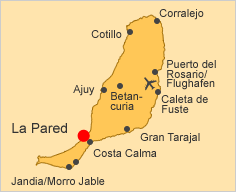La Pared

La Pared (in English: the wall) is a quiet town in the south of Fuerteventura. Private bungalows and holiday homes owned by both locals and residents characterise the townscape. The main attractions are the wonderful sunsets which you can watch from the beach of La Pared. Furthermore, there is a special micro-climate in La Pared, which earned it the title "Seaside resort with a therapeutic climate". The lonely beach and the surge are fascinating.
Map of La Pared

Information about La Pared
La Pared is situated at the isthmus which separates the peninsula of Jandía from the rest of Fuerteventura. The narrowest place of the island, called "Istmo de La Pared", is just about 4 km broad and covered by flat sand dunes.
In fact, there are two towns called La Pared. The old town lies a little further in the hinterland and is separated from the new town by a motorway. The new town lies directly at the seaside. This new estate has been established as "La Pared" in the last few years. La Pared belongs to the municipality of Pajara.
Originally, the town was planned by an architect as a larger tourist town. Today, however, La Pared is a quiet place with many private bungalows (many of which are rented to guests). Mainly residents and locals live here. The former hotel "Costa Real" has been closed for quite some time. There are no large apartment resorts like in Costa Calma or Jandía.

Old town of La Pared
When you enter La Pared you will be surprised since the first 150 m are not asphalted. Other small streets are not asphalted either. You will be surprised a second time when you see the big main road with pavements, benches and palm trees along the road. There is, however, hardly any traffic in La Pared.

Main road in La Pared

Main road in La Pared
The main attraction is probably the perfect location for enjoying a wonderful sunset. You can do that either directly on the beach, above the beach (many people watch the sunset here from the car) or in the fish restaurant "Bahia La Pared" (poss. reserve a table before).
Another distinctive feature of La Pared is its miro-climate ("Seaside resort with a therapeutic climate"). The protecting mountains keep off the winds from the Sahara. The northeast trade wind provides for balanced and quite stable temperatures. This is perfect for people suffering from respiratory diseases.
There is hardly any nightlife in La Pared; at least not traditionally in bars and discos. In the two restaurants ("El Camello" and "Bahia La Pared"), however, there is always something going on.
But there are many other leisure facilities: a surfing school directly in La Pared, a golf course with 9 holes (artificial turf), and a stable a little out of La Pared. The stable offers, amongst other things, rides along the beach. Moreover, there is a dairy in the old town of La Pared.
La Pared beach
The beach consists of several bays with fine sand. The largest bay is 900 m long.
La Pared beach cannot be compared to the beaches on the east coast of Fuerteventura. This is not meant negatively - the beach is very fascinating in its own way. Due to the few tourists the beach seems lonely, and only the loud sound of the sea is heard. These are ideal prerequisites for romantic sunsets.

La Pared beach with romantic sunset

Largest beach bay of La Pared

La Pared beach
Attention: there is always a strong surge and an extremely dangerous rip current! The beach is thus not suitable for bathing.

Partly dangerous currents
Surfers, on the other hand, take advantage of the constant surge in order to practice their sports.
Shopping and restaurants
As already mentioned above, La Pared is not the right place for those looking for parties. La Pared possesses two restaurants ("El Camello" and "Bahia La Pared").

Restaurant "Bahia La Pared" (fish restaurant), where you can enjoy the sunset
Today there is no longer a supermarket in La Pared. But you can quickly get to Costa Calma by car, on the other coast (about 7 minutes).
Bus/Taxi
At the town entrance there is a bus stop. You will find bus schedules mainly in island magazines, or just ask the bus driver. From La Pared, there are bus connections to Pajara, Costa Calma, Esquinzo and Jandía/Morro Jable.
At the moment, we do not know any traditional taxi stands; you can call a taxi only via telephone.
History
In the 15th century, a stone wall separated the peninsula of Jandía from the rest of Fuerteventura. This stone wall is said to have passed directly through La Pared.
In about 1960, the first construction sites developed in the new town of La Pared. A big holiday resort was planned here but until now, the town only consists of a number of single bungalows for residents, locals and a few tourists.

